Mist Maker FAQ
Categories
~ User Manual
Mist Maker Manual / Users Guide
Please read your manual carefully. There is a lot of important information included. Please also check out our FAQ Maintenance Section. Our "Things to Avoid" list will save us both time and money. Click here for troubleshooting a mist maker.

~ Build - Setup
How do I build a DIY humidifier with a Mist Maker?
To make a DIY humidifier, simply place an ultrasonic mist maker in a water reservoir, then use a small waterproof fan to push air into your water reservoir and the mist through output holes into your grow tent, room, or enclosure. You can create a fully automated humidifier by connecting a humidistat for automated humidity control and adding an auto-fill water valve. For step-by-step instructions, including recommended parts and assembly instructions, see our blog post on How to Build a DIY Humidifier.
How do I control the output of my mist maker?
You don’t need to adjust output just to make mist—your mist maker will run at full output by default. However, there are several safe ways to reduce or control mist output, depending on your specific needs:
- First: Never remove a disc to reduce output. Removing discs will damage your mist maker and void warranties. Never allow water under the discs.
- Precise, Automated Control:
For applications requiring accurate humidity—such as mushroom cultivation, laboratory humidification, meat or cheese curing, incubators or home humidification—use our humidistat controller. This device automatically cycles your mist maker on and off to maintain your desired humidity level at the preset levels. - Manual Output Adjustment:
For easy, hands-on control—ideal for special effects, cooling, or flexible environments—our Mist Output Controller lets you turn down the mist output with a simple voltage control dial.
Can I use a Mist Maker without a float?
A float is strongly recommended, but a mist maker can run without one as long as the water level and the mist maker’s position remain perfectly stable. You must maintain at least 20 mm (about 0.8 inches) of water above the surface of the ceramic disc at all times; too much or too little water will cause performance issues or stop mist production altogether. The supplied float automatically keeps your mist maker floating at the ideal depth for consistent operation and maximum mist output.
What size fan do I need for my humidifier?
The 120mm fan is our most popular choice and works well for most applications larger than 2x4 feet that also need sufficient fresh air exchange(grow tents). Use it for maximum mist dispersion in grow tents, greenhouses, rooms, or other similar spaces.
For smaller setups like terrariums or special effects, an 80mm fan is often sufficient. It provides enough airflow without overwhelming the space, or diluting the fog with air. This will give a foggy flow for a cool creeping fog effect.
Additionally, with larger mist makers, you can turn down the speed on a 120mm fan to achieve a similar slow-effect mist if desired. This is ideal for large mist makers when making a water-only fog machine.
What additives can I use to keep the water clean?
- Do NOT add bleach to your reservoir, as it WILL immediately damage the mist maker discs. It also chemically reacts with the stainless steel and will cause corrosion.
- The easiest method to keep water clean is to use our UV sterilizing light. Just drop it into the reservoir to kill bacteria and algae, greatly extending the time between cleanings and assuring the mist output is clean.
- You can also add 3% hydrogen peroxide at a 20:1 water-to-peroxide ratio once per week. Adjust the dosage based on effectiveness in your environment. You can also find stronger concentrations online.
- Always avoid mist makers with LEDs and clear reservoirs. The light in your reservoir will cause algae and promote bacterial growth.
Regular sterilization with these safe methods ensures optimal mist output and extends the life of your ultrasonic mist maker.
Do I plug the fan into the humidistat?
Most of the time, yes—the fan should be plugged into the humidistat. This setup allows the humidistat to automatically turn the fan on at the same time as the mist maker. Most humidistats, like our Willhi Humidistat, have one plug. Some have two, like our Inkbird Humidistat. However, on the Inkbird, one is for humidification and one is for dehumidification. With both Hydrometers/humidistats, you will need a plug splitter or power strip to plug both the fan and mist maker into the humidistat.
If your application requires fresh air exchange in the humidified area, you can run the fan constantly to maintain airflow independently of the humidistat's control and feed fresh air into your room using the fan. Then, when the mist maker turns on, it will humidify the incoming air.
Why is fog pushing up through my fan?
The most likely cause is that your fog output holes are too small. When the fog tries to escape the water reservoir, if the holes are restrictive, the pressure can push fog back up through the fan rather than flowing smoothly out the exhaust holes. A 4" output hole is recommended. Smaller holes will result in lower fog transfer and reduce efficiency.
To fix this issue:
- Increase the size of the output holes to allow the fog to escape freely, preventing it from being forced back through the fan blades.
- If your output holes cannot be adjusted, try reducing the fan speed. A slower fan speed moves less air, helping the fog flow properly without pushing back.
~ Humidification Sizing
What size mist maker should I choose for humidification?
Choosing the right size mist maker can be tricky because many factors affect your humidification needs. While some humidifier brands advertise coverage “up to 2000 sq ft” for certain units, actual requirements vary widely based on:
- Ambient humidity: Lower starting humidity means you’ll need more mist maker discs to raise moisture levels effectively.
- Target humidity: A higher desired humidity level also requires larger or more powerful units.
- Air exchange: The amount of fresh air entering the space plays the biggest role. Continuous air exchange (like open windows or HVAC) will require more output to maintain humidity.
- Room construction: Materials like concrete absorb moisture and can increase your humidification needs.
- Lighting and temperature control: Air conditioning or heating can impact humidity and mist maker performance.
- Temperature affects humidity absorption: Warmer air can hold and absorb more moisture than cooler air, so humidification is generally more effective and faster in warmer environments.
If your application has low air exchange, a smaller mist maker unit may suffice, but it may take longer to reach the target humidity. Conversely, in high air exchange environments, a larger, more capable unit is better to keep up with the air exchange rate.
It’s generally advisable to select a mist maker that can run less frequently at full capacity rather than an undersized unit that must run constantly. Remember, mist makers generate heat, and long run times in small reservoirs can raise water temperatures above 120°F, potentially damaging the discs.
What size mist maker for a terrarium or Martha Tent?
Choosing the right mist maker humdifier for a reptile enclosure, terrarium, or small grow space like a Martha tent is usually straightforward. Most users find that a single disc mist maker paired with either a 80mm fan for reptile tanks or a 120mm fan for Martha Tents works well.
For humidifying a small greenhouse or Martha tent 2x4X6 feet or smaller, a single disc unit can usually raise humidity to the high levels above 90% thats required for mushroom fruiting.
If your grow room area is 4x4 to 5x4 feet, consider upgrading to a 3-disc mist maker for better coverage and faster humidity adjustment. The 3-disc is especially recommended if you experience high air exchange, very low ambient humidity, or if you plan to expand your setup.
Check out our great article on building a Martha tent for mushroom fruiting for detailed instructions and tips.
What size mist maker for a medium sized applications?
Mist makers with 3 or 5 discs are commonly used for medium-sized spaces, such as:
- Mushroom tents or grow rooms, approximately 4x4 up to about 7x7 feet
- Greenhouses of similar size
- Bedrooms and living rooms that require moderate humidification without very high humidity levels
These units provide sufficient mist output to maintain stable humidity efficiently in these medium-sized environments.
Check out this customer’s video on building a DIY humidifier. He uses it to regulate humidity in a guitar building facility, but the same setup works great for any moderate-scale humidification project.
What size mist maker for large rooms or whole home?
For rooms around 10x20 feet or larger, or40' shipping containers, mist makers with 12 discs or 12XL units are typically required for 95% humidity levels in grow rooms, greenhouse, mushroom fruiting chamber humidification—especially for higher humidity targets or spaces with significant air exchange, hot grow lighting, heating or air conditioning. These larger units deliver the volume of mist needed to maintain stable humidity in 40' shipping containers, big grow rooms, greenhouses, or commercial setups.
For even larger applications, multiple mist maker units may be necessary to achieve adequate coverage and humidity control across the entire space.
What size mist makers for large/ XL applications?
Choosing a mist maker for around a 10x20' room or larger will most likely need a 12 disc or 12XL unit for higher humidity applications, or applications with high air exchange and lots of lights or AC. Much larger applications could take multiple units.
Check out this customers video on building a DIY humidifier. He's using it to regulate humidity in a guitar building facility, but can be used for any humidifying application.
What size mist maker for very large applications?
Sizing mist makers for very large spaces can be challenging due to multiple variables, including ambient humidity, air exchange, and heating or cooling systems in the environment.
Our 12XL Mist Maker kit, with a capacity of 9000 ml/hour, is designed to handle most large-scale projects effectively.
For projects larger than 20x40 feet with humidity targets up to 95%, it may be necessary to use multiple mist maker units to achieve consistent humidity levels throughout the space.
For example, in a warehouse setting where the current humidity is 20% and the target is 60%, if starting with one 12XL unit increases the humidity to 50%, you can assume your second unit would also add around 30%.
Based on this, adding a second unit would put your levels around 80%. Therefore, you can likely add a 9-disc mist maker to achieve your goals.
It’s generally advisable to overshoot your target humidity slightly. This reduces run times for each mist maker unit, preventing overwork and extending their lifespan.
Which Humidistat Should I Choose?
Both the Inkbird and Willhi humidistats are solid, reliable options with strong followings. The best choice depends on your specific needs:
- The Inkbird unit features two outlets: one for a humidifier and one for a dehumidifier. This makes it ideal if you require both humidification and dehumidification in the same space. However, if your sensor needs replacement, you must contact the manufacturer directly for parts, and the sensor requires disassembly for replacement.
- The Willhi model is favored for its easily replaceable sensor, which we recommend. Replacement sensors can be shipped directly from our warehouse, ensuring you’re back up and running quickly if a sensor fails.
Beyond this key difference, both units perform well and offer dependable humidity control and dependable sensors. Choose Inkbird if dual humidity/dehumidification control is necessary; choose Willhi for ease of sensor maintenance and fast support.
~ Fogponics
General Info on Fogponics Growing and Choosing the Right Mist Maker Size
Choosing the right ultrasonic mist maker size for fogponics growing can be tricky because every setup is unique. It’s harder to judge fog output visually compared to water volume contained in the fog. For 100% fogponic grows, a common mistake is buying an undersized mist maker that doesn’t produce enough dense fog to properly nourish plants. The fog needs to be very thick for effective nutrient/ moisture delivery.
Since it’s challenging to recommend one exact model, the best advice is to buy the largest mist maker you can comfortably afford. Here’s why:
- Larger mist makers generate fog quickly, minimizing required run times. It also increases the fog to air ratio.
- The goal is minimum air flow with maximum fog production.
- Shorter run times keep water temperature lower, protecting the unit and maintaining air temps in your root zone.
- For thick fog, run the fan at a low speed to push dense fog into the root zone without excessive fog dilution.
- Using a smaller fan, like an 80mm waterproof fan is ideal for fogponics, creating just enough airflow to move the fog. Larger fans like 120mm often over-dilute the fog unless you have a very large grow area.
Optimizing your mist maker size and fan setup ensures your plants get consistent, dense fog for healthy root absorption and improved growth in fogponics systems.
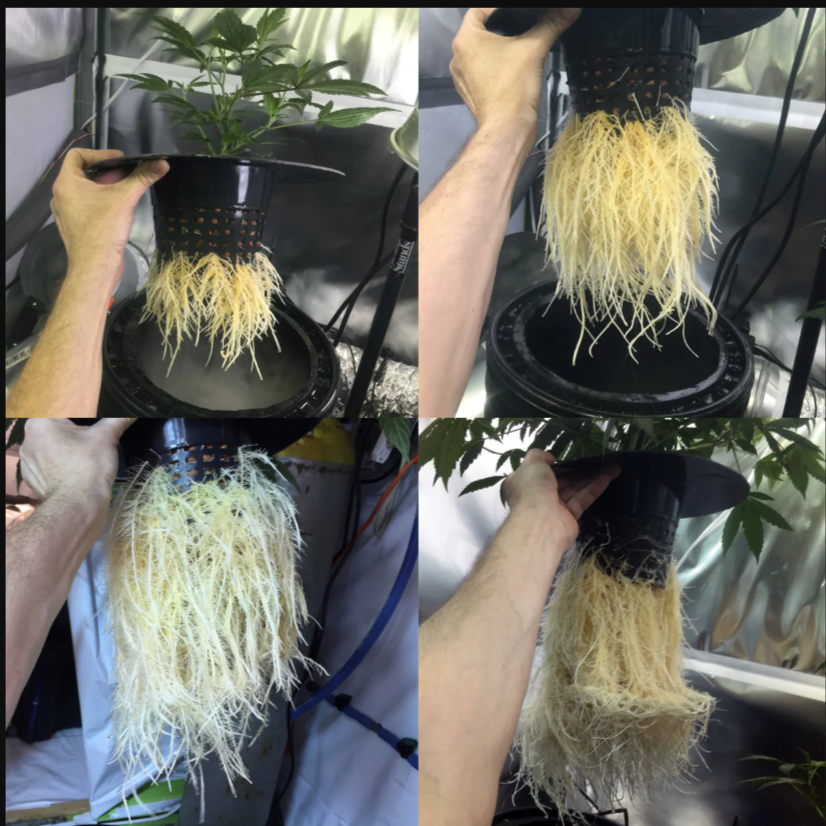
What size mist maker should I choose for fogponics growing?
For 100% fogponic grows with multiple growing sites, a 9 to 12 disc ultrasonic mist maker is typically recommended to ensure dense, consistent fog coverage throughout your system. Larger units deliver enough fog to effectively nourish your plants and promote healthy root development.
If you use a water chiller or a large reservoir that allows longer run times, or if you grow using a hybrid method—such as a combination of fog with shallow Deep Water Culture (DWC), Nutrient Film Technique (NFT), or the Kratky Method—you can opt for smaller mist makers. These methods submerge about 25% of the root zone in nutrient water, with the top 75% benefiting from fog, requiring less fog output overall. You can use a smaller unit with this method. Typically, a 3-5 disc for multiple sites, or a single disc for a 5 gallon bucket type grow.
How do I determine cycle times for fogponics growing with a mist maker?
To find the ideal cycle times for your fogponics system, start by running your ultrasonic mist maker until the fog in the root zone reaches its maximum density. This duration is your system’s “on-time.” Next, turn off the mist maker and observe how long it takes for most of the fog to dissipate—this is your “off-time.”
Using these initial on/off durations as a baseline allows you to fine-tune the fog cycles for optimal root hydration without over-saturating. Since every fogponics setup varies due to factors like grow space size, humidity levels, and plant types, it’s challenging to provide exact cycle times. However, this method gives you an effective starting point.
Regularly monitoring root zone moisture and adjusting cycle times helps ensure your plants receive consistent, dense fog essential for healthy growth in fogponics systems.
How do I use a mist maker for cloning?
How do I use a mist maker for plant cloning?
Using an ultrasonic mist maker for cloning is simple and effective, especially for small cloning setups. Typically, a single disc mist maker is sufficient to create the ideal fog environment for root development.
Keep in mind that fog is heavier than air, so you may need to raise the water level in your reservoir to keep the fog concentrated around the root zone. This ensures cuttings receive consistent humidity to promote fast and healthy root growth.
For a simple setup, it's as easy as adding about 4 gallons of water to a 5g bucket and dropping in a single disc unit. You can then use neoprene discs placed in holes in the lid to support your cuttings. This will hold the bottom of the cuttings in the fog, allowing for rapid root generation on your clones.
See a video of a fogponic cloning machine.
What is the Kratky Fog Method in Hydroponics?
The Kratky Fog Method combines the simplicity of the Kratky hydroponic technique with the innovation of fogponics to optimize plant root health and growth.
In this method, a fogger introduces dense, nutrient-rich fog to the upper two-thirds of the plant’s root ball, while the bottom one-third remains submerged in nutrient solution. This hybrid setup supplies roots with both moisture and oxygen in an energy-efficient, passive growing environment.
Because only the top part of the roots requires fog exposure, you can use a smaller mist maker unit compared to full fogponic systems. This makes it a great way for growers to start experimenting with fogponics while leveraging the simplicity of the Kratky method.
The Kratky Fog Method offers a low-maintenance, effective way to deliver nutrients and oxygen to roots, encouraging fast growth and healthier plants.
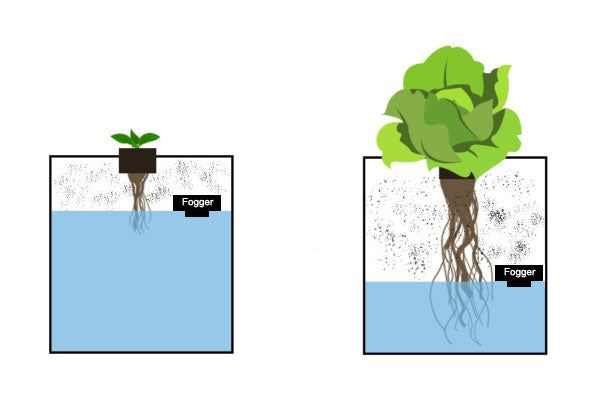
How do I make my own Nutramist fogponics unit?
Making your own Nutramist fogponics system is easy and budget-friendly. Here’s a simple guide to get started:
- Find an airtight container like a 5-gallon bucket as your main reservoir.
- Drill a hole for a small waterproof fan to provide airflow and one for your fog output hose.
- For nutrient supply, create a separate external reservoir (another 5-gallon bucket works well) connected by a mini float valve that maintains the water level in the main unit automatically.
- Place your ultrasonic mist maker disc inside the main reservoir at the correct water level for optimal fog production.
- Connect the fan and fog output with tubing to direct dense, nutrient-rich fog to your root or cloning chambers.
This DIY setup provides a versatile, efficient fogponics environment ideal for cloning, propagation, or growing various plants with focused root zone humidification.
For a detailed step-by-step visual walkthrough, watch our DIY Nutramist / Fogponics setup video showing all components and assembly tips.
How do I make a Vertical Fogponics Tower?
Making a Vertical Fogponics Tower is an easy and innovative way to start growing with fogponics. The simplest approach is the 5-Gallon Bucket Hybrid Kratky Method, which combines passive nutrient delivery with fog misting.
One key thing to remember with vertical towers is that fog is heavier than air and tends to settle at the bottom. Because of this, fog needs to be introduced at the top of the tower, not the bottom, to ensure proper circulation.
A popular design is a hybrid drip/fog system where the ultrasonic mist maker is mounted at the top (without the black float) in an overflowing container fed by a nutrient pump at the bottom of the tower. Nutrient solution pumps up, feeds the fogger, then overflows down the roots, returning to the reservoir.
Depending on the tower size, you can use anywhere from a single disc mist maker up to a 12 disc unit. Some customers use a single disc fogger that pumps nutrients to the top, producing dense fog that nourishes roots between pump cycles.
You can also achieve 100% fogponic growth with a vertical tower by using an external fog generator supplying fog directly to the top, while condensation collects at the bottom. For dense fog coverage in 100% fogponics, a minimum of a 5 disc mist maker is recommended for towers of similar size.
To learn more, check out our video on building a DIY Vertical Fogponics Tower and see detailed diagrams for assembly.
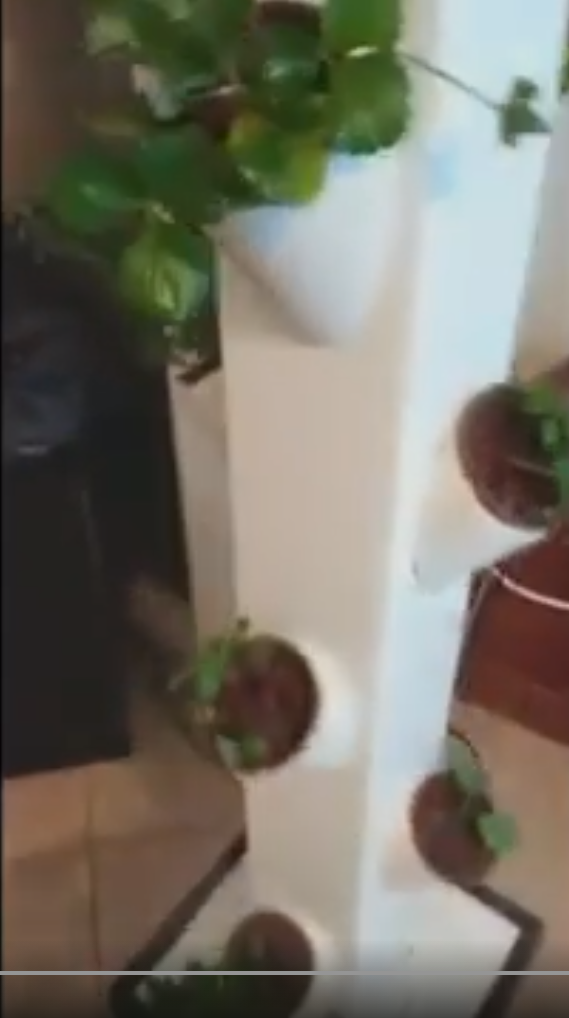
Will Mist Makers carry fertilizer or anti-fungals in the fog?
Yes! The water droplets created by a mist maker will carry everything dissolved in the reservoir water—including minerals, nutrients, and antifungal treatments. Unlike humidifiers that heat water and may affect nutrient delivery, mist makers use ultrasonic vibrations to create a fine, nutrient-rich fog. It is possible that nutrients that are not water-soluble will not be transported. It's recommended to use additives that are water-soluble. Things like organic fertilizers that have gritty particles will not transport in the fog.
This makes mist makers ideal for applications like fogponics growing, anti-fungal, and sterilization, where you want nutrients or treatments delivered directly to roots or plant surfaces. You can even treat for things like spider mites with a mist maker. The fine fog ensures excellent absorption and effective distribution of fertilizers and antifungals, helping plants thrive.
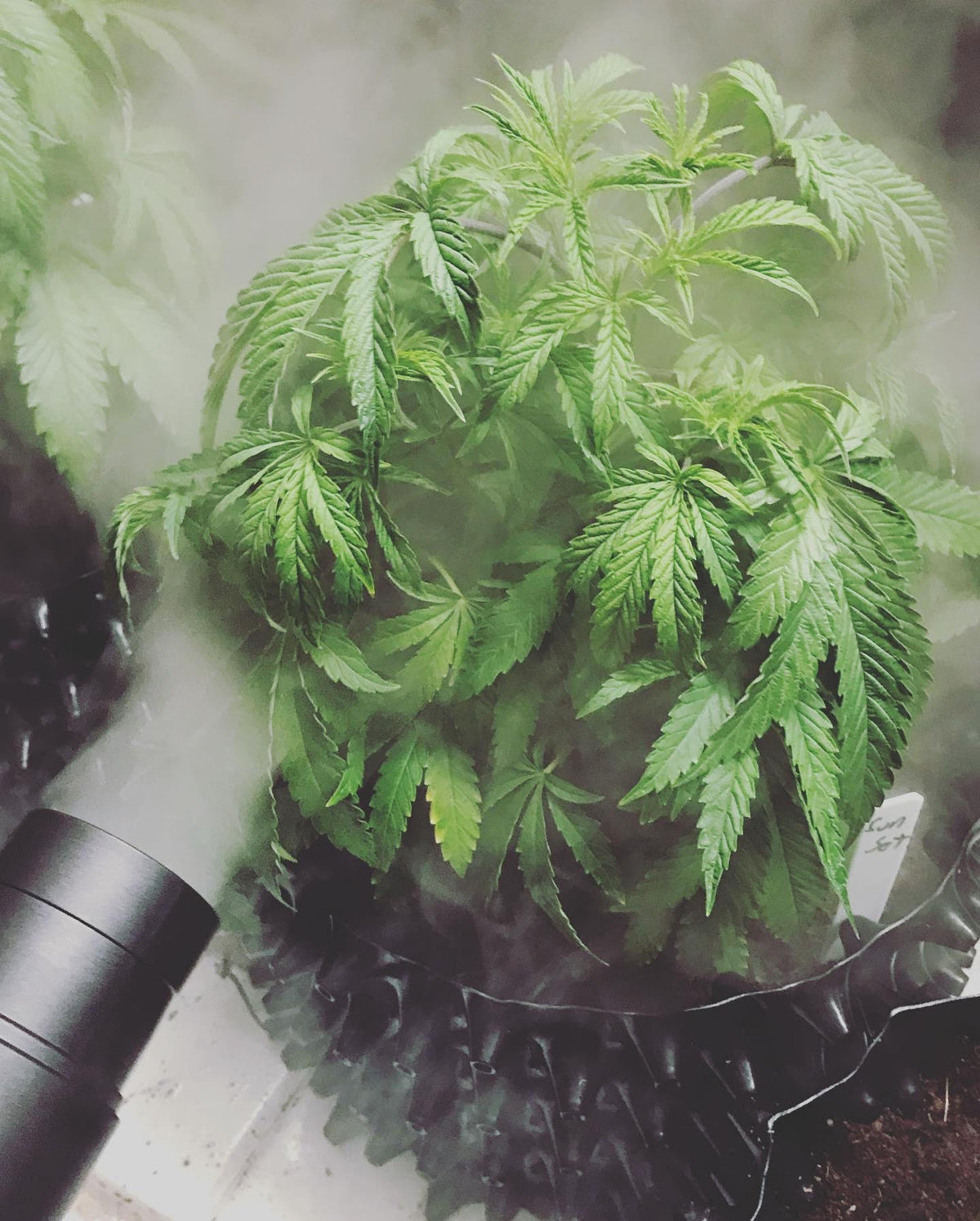
~ Ultrasonic Mist Maker Maintenance
Maximize Lifespan & Performance of Ultrasonic Mist Makers
Avoid these common mistakes that reduce fogger lifespan and performance:
Overuse: Limit continuous running to 8 hours with at least 1-hour rest periods. Avoid running for longer cycles without breaks. Running unit with smaller cycles ie. 30 min on/ 10 off is ok.
Wrong additives: Never use bleach or slimy additives; use vinegar for cleaning mineral buildup, and hydrogen peroxide or our UV light for sterilizing the water reservoir.
Low water level: Running in too little water overheats the unit since water acts as a cooling agent. Do not rely on the mist maker shutting off due to low water in order to alert you to add water to the reservoir. This can cause overheating and shorten the lifespan of the fogger, or even cause immediate damage.
High water temperature: Keep water below 115°F. For 6–12 disc models, a large 27-gallon Tuff Tote container works best to maintain cooling even as water levels drop. Small containers like a five-gallon bucket are ok for 1 and 3 disc units. A 10 Gallon bucket is ok for a 5-disc unit. Containers with a large footprint are better because the water sensor will shut down the unit with a few inches of water in the reservoir. The large footprint will leave more water in the container during shutdown.
Moisture in spring area: Never allow water into the spring area during disc changes. Always dry the unit completely before removing discs. Always remove discs and dry the spring area before long-term storage.
Handling and cord care: Never lift the mist maker by the power cord or water sensor. It can break the seal and cause permanent damage. Ensure the power cord isn’t pinched by reservoir lids, as this can tilt the unit and pull the transducer out of the water while leaving the water sensor activated. This will quickly damage the unit. Leave sufficient slack in the cord inside the water reservoir to prevent this.
Pure water: Using ultra-pure water (distilled, RO, or A/C discharge) with TDS below 15 ppm can cause stuttering or stress. Adding a small amount of salt or calcium carbonate or mixing with tap water improves mist production and reduces stress on the mist maker. While not necessary, RO water is usually the best option all around, but all water is fine.
Proper storage: Remove ceramic discs and completely dry the spring area before long-term storage to prevent corrosion and spring failure. The fogger can be stored with discs installed if the spring area is dry before storage. Be careful to avoid damage to the water sensor on the transducer
Avoid running multiple units: Using more than one ultrasonic fogger in the same tank (9, 12, or 12XL models) can cause electrical interference and faster disc wear. It can be done if needed, but it can cause the discs to be changed more often
Protect in cold weather: Avoid frequent on/off cycling in freezing conditions, which can cause transducer damage due to expansion/contraction. Using an aquarium heater set below 100°F can prevent damage.
Correct float assembly is critical: The mist maker must float freely on sufficient water in the reservoir. The mist maker will not run without a float if it is submerged in water. This can damage the fogger.
Ensure the float’s two pieces are fully pressed together so the water sensor sits deep enough in the water.
Oftentimes in shipping or during maintenance, the float can separate and hold the unit too high out of the water because the inner ring sits too low in the shell of the float.
To adjust the float, flip it over, align the tabs, and press the inner donut ring firmly into the shell until fully seated.
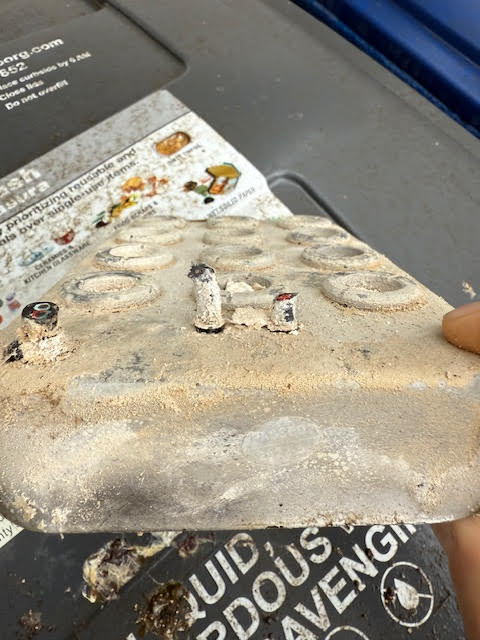
How do I change mist maker discs?
If you notice a drop in mist output, the first thing to check is if there is water trapped under the discs. If the area is dry, you probably just need to clean the discs. If cleaning the discs doesn't work, changing them is recommended.
Here’s how to safely change or clean your ultrasonic mist maker discs:
- Dry the silver transducer thoroughly.
- Use the silver disc key that came with the free replacement discs in your order to unscrew the silver retaining rings and carefully remove the rings. Use caution. The internal springs can cause the discs to jump out of their place. Discs dropped on the floor should be discarded. They're ceramic, and hairline cracks can cause them to break and damage the transducer.
- Remove the white ceramic disc by gently popping it out with a soft instrument or your thumbnail. Be cautious as discs may stick to the clear O-ring underneath. DO NOT lose the O-rings—they create a watertight seal essential for proper operation.
- Soak the ceramic discs in white vinegar for a few minutes to loosen deposits, then wipe them clean with a soft cloth.
- Ensure all o-rings are in place and install the new discs. Use the silver key to tighten the retaining rings until very snug. The key should twist slightly, but not so much it is permanently distorted. Do not overtighten.
Important: If you are installing brand new discs, discard the black protective ring that comes with them. It is NOT a replacement for the clear O-ring, which remains reusable for the life of your mist maker.
For video guidance, watch our detailed video on changing mist maker discs: How to change mist maker discs.
What is the best way to clean and sterilize an ultrasonic humidifier reservoir?
The best way to keep an ultrasonic humidifier’s reservoir clean and sterile is to use regular cleaning with white vinegar, apply hydrogen peroxide for weekly sterilization, and avoid chemicals like bleach to protect both the device and air quality.
Ideal Routine (Per Gallon Basis)
- Weekly Vinegar Rinse: Mix 1 cup of plain white vinegar with 1 gallon of warm water. Pour into reservoir, let soak for 15–30 minutes, gently agitate, then rinse thoroughly and air dry. You can spray the dry reservoir with rubbing alcohol and allowit to dry in order to sterilize it if needed.
- Hydrogen Peroxide Sterilizing: Add 6–7 ounces (just under 1 cup) of 3% hydrogen peroxide per gallon of water, once a week, to thoroughly sanitize the tank and reduce biofilm buildup. Higher strength peroxide can be found online to reduce your costs if using this method.
- UV Sterilizer: For the cheapest, most consistent way to keep it clean, is to run a UV sterilizing light in your reservoir. Run it for about 3 hours per day to minimize cleaning frequency and ensure ongoing disinfection. You can extend these times if needed.
- DO NOT USE Bleach: Do not use bleach. Adding bleach to the water will permanently ruin discs and have a chemical reaction with the stainless steel casing of your transducer. This will cause it to corrode quickly.
What is the best way to clean the ultrasonic mist maker transducer?
To clean the ultrasonic mist maker transducer safely and maintain peak mist output:
- Spray the mist maker transducer gently with white vinegar. Allow it to sit for a few minutes to dissolve mineral deposits and biofilm.
- Use a soft toothbrush or brush to gently scrub the ceramic discs to remove buildup. Avoid using abrasive tools or harsh chemicals like bleach.
- Wipe the transducer clean with a soft cloth afterward. The white discs can be cleaned and rinsed in place without removing them.
- Be extremely gentle with the U-shaped water level sensor. Only clean it if necessary, and never bend, adjust, or manipulate it as this can break solder joints or the watertight seal. Some buildup is acceptable if it doesn’t reduce performance.
- If mist output remains low after cleaning, completely dry the silver transducer before carefully removing the discs for replacement. Do not allow moisture under the discs. Make sure o-rings are in place before replacing the discs.
NOTE: the black rings on the new discs are NOT o-rings. They're for protection when in the package.
- Never use bleach for cleaning the transducer, discs, or reservoir. Bleach corrodes stainless steel components and leaves a film that damages discs immediately and permanently. Bleach can ruin the transducer as well.
- For video guidance, consider watching this video on changing discs in an ultrasonic mist maker: How to change the discs in an Ultrasonic Mist Maker.
Following these steps helps maintain the longevity and efficiency of your mist maker while keeping it safe for continuous use in humidification, grow tents, and fog projects.
How should I properly store my ultrasonic mist maker for long-term periods?
Proper long-term storage is essential to protect your ultrasonic mist maker and ensure it performs well after sitting idle.
- Remove the ceramic discs before storing the unit if it will be unused for more than a week or so. Any moisture trapped under the discs may cause corrosion or degrade the transducer function. If available, use a hair dryer to dry the spring area under the discs before replacing them for storage.
- Store the unit in a cool, dry place, ideally inside its original packaging or a similarly protective container to avoid dust and physical damage to the water sensor.
- Do not leave sitting in water during storage. While it's ok to leave it in water during daily use, leaving it in water without at least daily use is not recommended.
- Avoid manipulating or damaging sensitive parts such as the water level sensor or power cord during storage. Leaving the transducer in the black float can help protect the water sensor.
Following these steps will help keep your ultrasonic mist maker in optimal condition during seasonal downtime or extended breaks between use. When ready to use again, inspect and clean the discs and reservoir before operation to assure longevity and performance.
What are the maximum run times and ideal water temperature for ultrasonic mist makers?
Maximum run time: The mist maker can run up to 8 hours continuously, followed by at least 1 hour off to prevent overheating and prolong device life. These cycles can be broken into shorter intervals as needed based on your usage and environment. For example, 1 hour on, 15 minutes off.
- Water temperature limit: Keeping the water temperature below 120°F (49°C) is critical. Ultrasonic mist makers heat the water they operate in, and excessive temperatures can swell the internal cooling tube and cause failure. Temperatures higher than this can also cause premature disc wear.
- Reservoir size guidance: When using a mist maker for extended periods, like in hummdification, it's important to have enough water to maintain proper temperature and function. Use a sufficiently large reservoir for best outcomes.
- Units with 3 discs or fewer are best suited for 5-gallon containers or larger. Be sure to keep water levels high. Larger 5-disc mist maker units can use a 5-gallon container if the water level stays full. If this is not possible, use a larger reservoir. The 9 and 12 disc units require reservoirs of 20 gallons or more.
- TIP: Use a container with a large footprint. This way, when the water runs low, there will be sufficient water in the bottom of the container to keep the unit cool. It is still advised to keep at least 10 gallons of water in the container for the larger 9 and 12-disc units.
Running mist makers within these limits ensures efficient fog production, protects the electronics, and extends the lifespan of your unit in mushroom growing, home humidification, fog effects, and more.
How do I troubleshoot my ultrasonic mist maker if it stops producing fog?
If your ultrasonic mist maker fails to produce mist, the first step is to identify whether the issue lies with the silver fogging transducer or the black transformer (power supply).
- Most commonly, problems originate with the silver fogging transducer. This is the component that holds the discs that vibrate to create mist, and it can experience wear, mineral buildup, or damage over time, reducing mist output.
- The black transformer (power supply) is usually not the cause of fogging issues, but it’s still important to check for power, correct voltage output, and any visible damage or overheating signs.
- For comprehensive, step-by-step troubleshooting instructions, refer to the dedicated guide here: Troubleshooting an Ultrasonic Fogger.
~ General Questions about Ultrasonic Mist Makers
What are mist makers used for?
Ultrasonic mist makers have a wide range of applications across various industries and environments. Some users need up to 95% humidity for mushroom spawning, while others use them to humidify bedrooms or even build DIY whole-home humidifiers to maintain comfortable humidity levels around 55%. Mist makers are even used to create ultra-realistic fake fire effects, like the one featured in Katy Perry’s music video, using fake fire on our Instagram.
Common Uses for Ultrasonic Mist Makers
- Mushroom Fruiting
- Fogponics
- Reptile Enclosures
- Greenhouse Humidification
- Home Humidification
- Commercial Humidification
Rare and Interesting Applications
- Sterilization
- Guitar Building
- Gasoline Nebulization
- Automotive Water Injection
- Wine Aging
- Concrete Curing
- Cheese Caves
- Meat Aging
- Hot Yoga
- Dust Control
- Swift Nest Breeders
- 3D Printing
- T-Shirt Printing
- Equipment Cooling
- Odor Control
- Essential Oil Dispersion
- Foliar Feeding
- Incubator Humidification
- Laboratory Climate Control
- Stage Fog
- Fog Screen for Projections
- Pond and Hardscaping
- Haunted Houses
- Growing Sprouts & Spouting Seeds
- DIY Fogponic Cloners
- Realistic Fake Fire Effects
- Wind Tunnels
- Science Center Projects
- Tornado Simulators
- Mold Control and Remediation
- Fish Tanks
- …and many more!
What kind of water should I use with my ultrasonic mist maker?
Most types of water can be used with an ultrasonic mist maker. Water that contains at least 15 parts per million (PPM) of total dissolved solids (TDS) is preferred, but not mandatory. This level of dissolved solids is recommended for the mist maker’s water level sensor to function properly and create a strong electrical connection to activate the unit. Less than this can cause a stuttering, or "vibration" in operation. It can cause reduced output and stress the unit.
- Avoid using pure distilled or ultra-pure reverse osmosis (RO) water with very low TDS (below 15 PPM). Using such water may cause the mist maker to operate erratically and produce inconsistent mist.
- Hard water is acceptable, but requires more maintenance. Hard water may lead to calcium and mineral buildup on the ultrasonic discs, which results in white dust deposits around the misting area. You should clean the discs regularly by wiping them with a clean rag or Q-tip to remove scale if using hard water.
- If you notice white dust accumulating on surfaces, it indicates your water has a high mineral content. Regular cleaning helps maintain optimal mist output and prolongs the lifespan of the mist maker.
Choosing water with a moderate TDS level balances sensor function and maintenance needs, ensuring consistent fog production and reliable operation.
What frequency does a mist maker operate at?
House of Hydro ultrasonic water foggers use high-output ceramic discs that vibrate at approximately 1.7 MHz (megahertz). This high-frequency mechanical oscillation produces microscopic water droplets smaller than 5 microns, creating a cool, dry fog ideal for reptiles, greenhouses, mushroom growing, and home humidification around electronics.
The ultrasonic mist maker uses a piezoelectric transducer to generate these vibrations just below the water’s surface. Unlike other fog machines, mist makers do not employ dry ice, fog liquids, heat, or chemicals—resulting in silent and chemical-free humidification.
What is the Tuff Coat, Anti Corrosion Coating?
What is the Tuff Coat Anti Corrosion Coating and why do you offer it on HOH mist makers?
Tuff Coat is a superior, aerospace-grade anti corrosion coating originally tested and proven in rigorous salt fog chamber environments by university researchers commissioned to evaluate top corrosion inhibiting compounds (CICs) used in the airline industry.
- It is a heavy-duty, water-displacing, super-penetrating food safe coating that forms a tough, tack-free film with exceptional resistance to salt, moisture, and corrosive chemicals.
- This coating repels corrosion for many months longer than standard commercial CIC sprays, greatly extending the service life of ultrasonic mist makers, especially in abusive environments involving fertilizer, gasoline, perfumes, salt water, and hard water.
- The Tuff Coat used on our mist makers is specially applied by a local body shop with multiple spray-and-bake coats, delivering a unique, durable finish not commercially available elsewhere.
- It is food safe, chemically resistant, and designed for long-lasting performance, although certain chemicals may cause the coating to turn chalky white—this is normal and does not affect its protective qualities.
- Tuff Coat is not a paint; it’s difficult to apply evenly and may have slight surface imperfections (runs), but these do not compromise its corrosion protection capabilities.
- The coating is highly recommended for users with demanding applications or those who want to double their warranty coverage thanks to the enhanced protection it provides.
- See more about the Tuff Coat Here
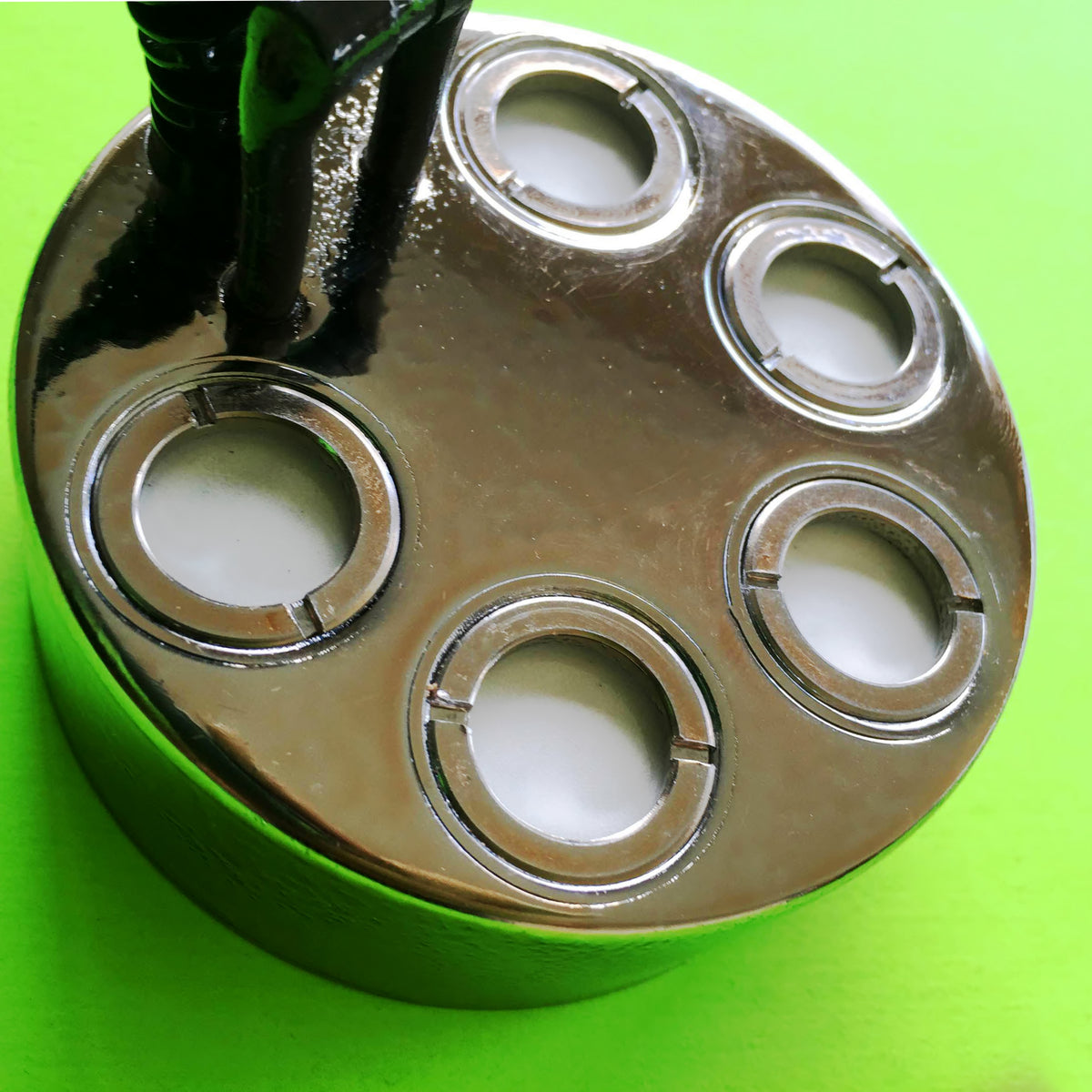
Are The House of Hydro’s mist makers the same as other mist makers?
No! The House of Hydro ultrasonic mist makers stand apart in key ways:
- Stainless Steel Construction: Built with rugged stainless steel for superior corrosion resistance and safe use in food-grade applications. Many other mist makers use cheap metal with chrome plating that can corrode and leach harmful chemicals into water.
- High-Output 20mm Ceramic Discs: Larger ceramic discs coated with a clear non-stick glaze offer five times longer life and easy cleaning compared to competitors’ smaller, 16mm brass discs.
- LED-Free Transducers: Prevent algae growth and electrical issues common with LED-equipped units, greatly enhancing reliability.
- Wide Range of Models & Powerful Performance: From single-disc units for small terrariums to 12XL kits for large commercial use, with industry-leading mist output and coverage.
- Complete Kits with a proven high-quality line of accessories: Starter kits include float rings, power transformers, and spare discs. The available optional Tuff Coat anti-corrosion coating is only available at The House of Hydro.
- One day order processing: most orders ship within one business day!
- Industry-Leading Warranty and American-Based Support: The House of Hydro offers an industry-leading warranty backed by an American-based company that truly understands the critical role humidity plays in applications like mushroom growing, laboratories, and greenhouses. They go above and beyond to swiftly get customers up and running should any issues arise, ensuring peace of mind and customer satisfaction.
This combination of premium materials, advanced engineering, comprehensive customer care, and unmatched warranty protection makes The House of Hydro mist makers the best choice for serious hobbyists and professionals alike.
How does an Ultrasonic Mist Maker work?
House of Hydro ultrasonic mist makers operate similarly to a subwoofer if you were to pour water into the cone. As the subwoofer fires, it would break the water into droplets and throw them into the air. In a similar fashion, ultrasonic mist makers use high-output ceramic discs that vibrate at an ultrasonic frequency (around 1.7 MHz) to silently create microscopic water droplets smaller than 5 microns.
These ultrasonic vibrations are generated by a piezoelectric transducer that produces high-frequency mechanical oscillations just below the surface of the water. This vibration causes the water to break into a fine, dry mist that instantly evaporates into the air, providing effective humidification without heat, steam, or chemicals.
Because the fog is produced mechanically rather than through heat or chemicals, ultrasonic mist makers generate a cool, clean fog that is ideal for sensitive environments such as reptile enclosures, greenhouses, mushroom cultivation rooms, and home humidification with electrical components.
The fog generated is considered a "dry fog" due to its small particle size. Under most circumstances, it does not wet surfaces unless applied under force, or in extremely heavy applications.
Unlike other fog machines, mist makers do not use dry ice, fog liquids, heating elements, or chemicals, making them safe and energy efficient for continuous use.
Are Mist Makers safe to use around animals, children, or smoke detectors?
Yes, ultrasonic mist makers are safe and can be placed nearly anywhere. The fog produced is cool, dry, and chemical-free, making it suitable to use around electrical appliances, smoke detectors, pets, and fish tanks without risk.
However, never touch the ceramic discs while the unit is operating. The ultrasonic vibrations produce a strong sensation similar to an electric shock or burn "felt all the way to the bone," which can cause hurt, but doesn't cause injury with a quick touch.
Mist makers do not make noise aside from a quiet bubbling water sound, making them perfect for in-home use.
Reptiles, fish, and birds have shown no stress with use. We have many mist makers in a local pet shop that have used them in coverless fish tanks for aesthetics, as a humidifier for reptiles, and even in their kennel area for odor and dust control.
Following these guidelines keeps ultrasonic mist makers safe, effective, and long-lasting for use in humidification, reptile habitats, mushroom cultivation, greenhouses, and fog effects.
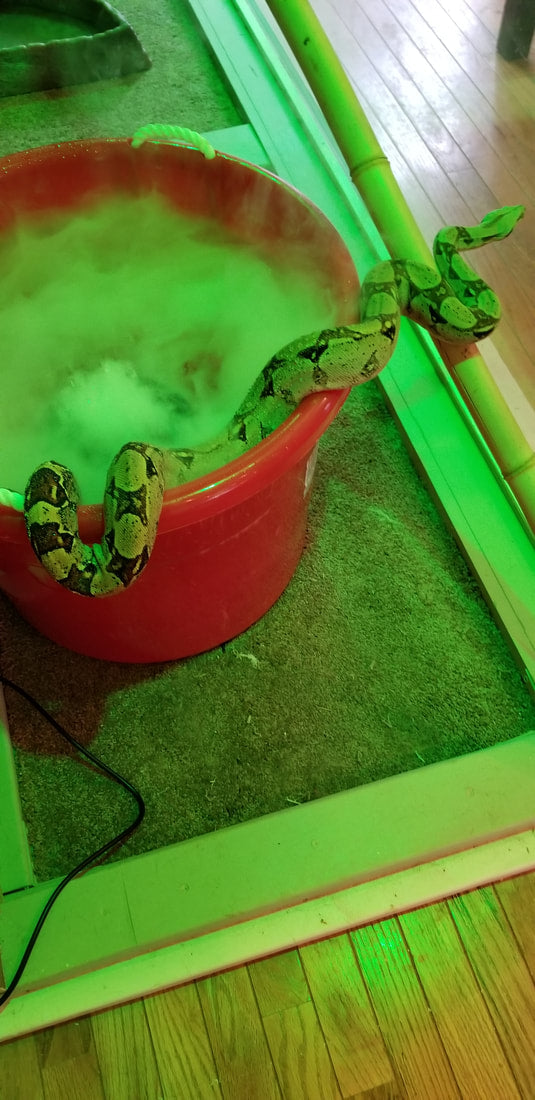
How do I use essential oils, or oil based additives with a mist maker?
You can use various oils with an ultrasonic mist maker, including essential oils, but keep in mind that many oils increase the surface tension of the water and can reduce mist output.
To counteract this, try using an emulsifier or plant-safe surfactant like Coco-Wet, which improves water spreadability and maintains strong mist production. Emulsifiers can also be used for non-plant applications.
The limiting factor is viscosity. Oils can be used with a mist maker, but most often, not alone. The oil must be mixed with water using an emulsifier for the best effect.
For essential oils, a few drops can be placed in the water without an emulsifier, but for large amounts, an emulsifier is recommended.
Important safety notes:.
- Regularly clean your mist maker discs with vinegar or mild detergent solutions to prevent buildup from oils or minerals.
- Consider that some oils and additives may alter mist particle size or fog density, so start with small doses and observe performance.
Using oils and additives carefully can expand the functionality of your mist maker for aromatherapy, sterilization, foliar feeding, or insect control.
How long do the mist maker discs last?
The typical factory lifespan of our ceramic ultrasonic mist maker discs is approximately 3,000 to 5,000 hours of operation compared to 1 -2000 hours for brass discs.
Disc life can vary significantly based on the quality of water used, water temperature, and how well you maintain your mist maker by regularly cleaning the discs.
- Using clean, moderately mineralized water and avoiding harsh chemicals like bleach helps extend disc life.
- Regular cleaning of discs with white vinegar or mild solutions removes buildup and fouling that can degrade performance over time.
- Running the mist maker within recommended water temperatures (below 120°F) and proper reservoir sizing also preserves disc longevity.
Good maintenance combined with quality water can help you maximize the life of your mist maker discs while ensuring consistent mist production.
Why can't I use the cheap LED mist makers in a humidifier?
Cheap mist makers with LEDs built into or near the transducer discs will cause algae growth and biofilm in the water, even with one small LED common on many mist makers as a power indicator. This algae proliferation creates a host of problems, especially in home, hydroponic or fogponic growing setups where algae can compete with plants for nutrients, clog systems, and reduce overall health and yield.
In contrast, The House of Hydro mist makers are 100% LED-free to prevent this issue, making them more reliable and suitable for sensitive applications like mushroom cultivation, greenhouses, and home humidification.
Algae and biofilm growth in store bought humidifiers is common and can cause several health problems. The primary issues include:
- Breathing contaminated mist containing bacteria, fungi, and algae that can cause lung problems ranging from flu-like symptoms to serious infections, especially in people with allergies, asthma, or weakened immune systems. This can be prevented by using an LED-free mist maker combined with our waterproof UV light sterilizer in the reservoir.
Overall, contaminated humidifiers can worsen respiratory health and cause allergy or asthma flare-ups. Regular cleaning and proper maintenance to prevent biofilm and algae buildup are essential to reduce these risks. Using a DIY humidifier that can be easily cleaned and has our UV Sterlizer added can give you safe, clean humidification compared to store-bought units that are hard to disassemble, and don't have added safety of a UV light.
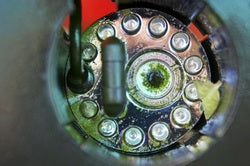
Can mist makers be used in a Dimplex Opti Mist Fireplace?
Yes, many customers have successfully used House of Hydro ultrasonic mist maker transducers to replace the original Dimplex units. The House of Hydro transducers typically come with longer power cords, which generally makes installation manageable for most users.
When troubleshooting or upgrading your Dimplex fireplace’s mist system:
- If there is no water movement at all, you likely need to replace the entire transducer.
- If there is some water movement, replacing just the ceramic disc(s) may suffice, though this is not guaranteed.
- You can measure your mist maker discs with a standard penny: if the disc is larger than a penny, it is a 20mm disc; if smaller, it is a 16mm disc. Replacement discs and transducers are available separately or as part of complete House of Hydro Mist Maker kits.
House of Hydro offers genuine, high-output replacement parts that fit many Dimplex models, giving you a cost-effective way to restore or enhance your fireplace’s mist performance.
Can I use a mist maker like a Zoo Med Repti Fogger?
Yes! House of Hydro foggers are trusted by the Amphibian Foundation of Atlanta to maintain proper humidification in their enclosures.
The humidity created by a mist maker is excellent for reptile enclosures. You can easily create your own repti fogger setup by placing the mist maker in a small container with a fan to disperse the mist. Alternatively, you can simply allow gravity to drop the mist into the tank, or place the fogger in your enclosure in a water bowl.
Mist makers are a better option! DIY Reptile foggers allow for less refilling and easier cleaning than a Repti Fogger. They produce a fine, cool fog that helps maintain high humidity and mimics natural environments for reptiles. They are a cost-effective and simple alternative to commercial repti foggers, providing consistent moisture without wetting surfaces excessively.
A mist maker-based repti fogger is an efficient way to keep reptiles happy and healthy with proper humidity control.
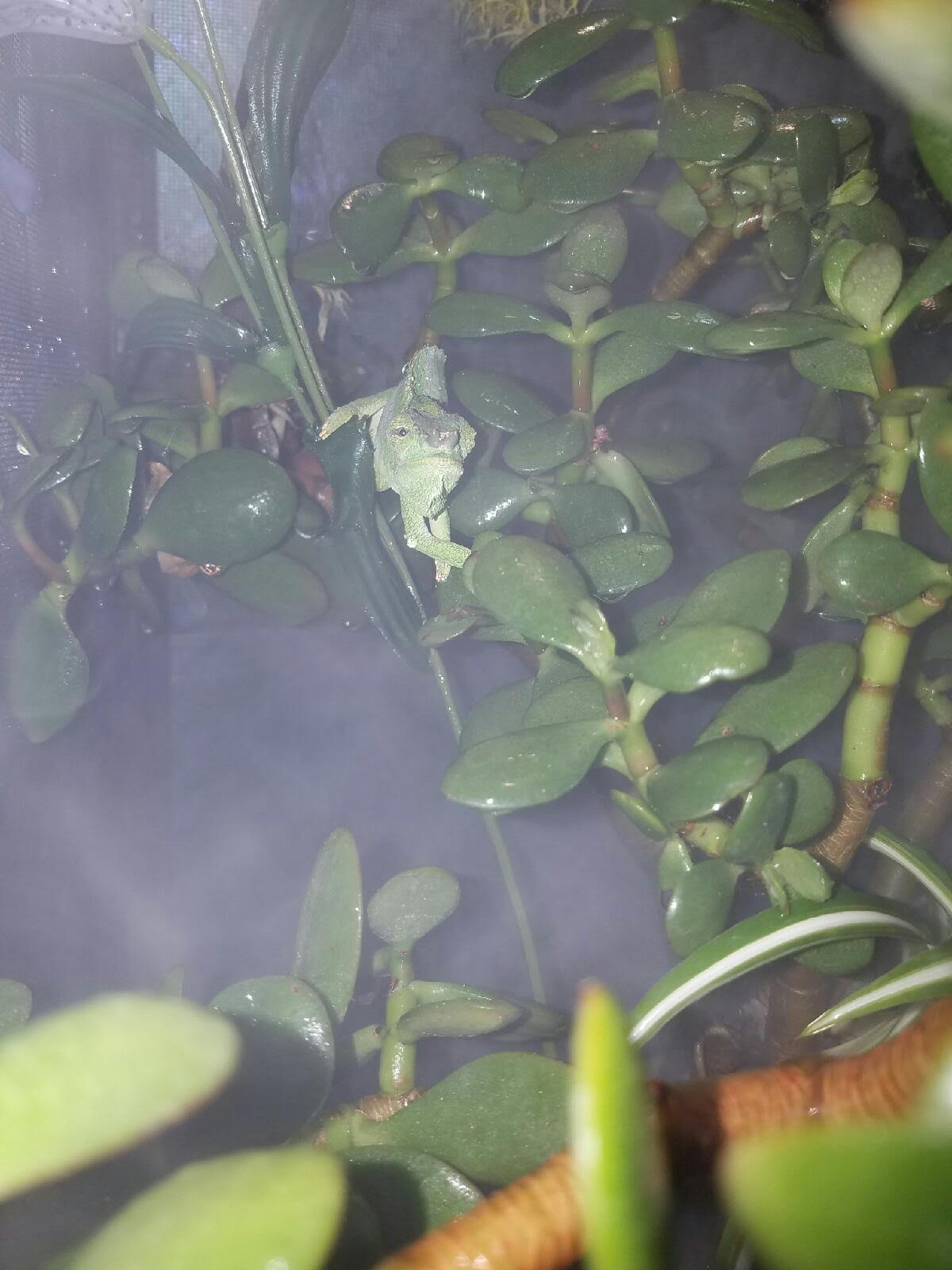
Can Mist Makers clean the air in your home?
Yes! The mist produced by an ultrasonic mist maker is negatively charged, while dust and allergens in the air tend to be positively charged. This charge difference causes the particles to bind together, making them heavy enough to settle onto the floor or surfaces where they can be easily cleaned or vacuumed away.
For example, a customer running a 12-disc mist maker with a 120mm Hydro Flow Fan in a pet store with dusty shredded newspaper bedding found that it significantly reduces airborne dust and odor, improving air quality noticeably.
This electrostatic effect helps the mist maker not only humidify but also remove dust, allergens, and pet dander from the air, making it an excellent choice for allergy sufferers, pet owners, and anyone needing cleaner indoor air.
Can you use a mist maker in reverse osmosis (RO) or distilled water?
- Distilled (not RO) water alone can be used effectively with a mist maker, but it's not recommended. This is because the mist maker’s water level sensor requires at least 15 PPM (parts per million) of total dissolved solids (TDS) to function fully. Distilled water typically has near-zero TDS, causing the unit to stutter or pulse intermittently. This inconsistent operation stresses the mist maker and can lead inefficient operation.
- You can use reverse osmosis (RO) water, but it's best if the TDS level is above 15PPM. If your RO water has very low TDS, consider adding a small amount of tap water, calcium carbonate, or salt to increase dissolved solids. This strengthens the electrical connection to the water level sensor and stabilizes mist maker operation.
- Maintaining proper TDS levels also helps reduce stuttering and prolongs the lifespan of the mist maker discs and electronics.
In summary, use water with moderate dissolved solids content for optimal mist maker function, and avoid pure distilled water alone if possible to prevent operational issues.
~ Shipping - Orders
What are the shipping rates and duty tax for The House of Hydro mist makers?
- Shipping to the USA is free: Orders are typically shipped with one busness day via USPS or UPS Ground. Faster shipping optionas are available at checkout.
- For international orders, shipping is offered at the lowest possible price, helping customers worldwide get quality mist makers affordably.
- Please note that your country may charge import duties or taxes upon delivery if you live outside the USA. Your local customs authorities determine these charges and are the buyer’s responsibility. They are not included in the price.
- Shipping times vary based on location, with standard international delivery generally taking 10-15 business days, subject to customs handling and unforeseen delays.
- Customers will receive tracking information once the order ships.
Do you sell 230V, and ship internationally?
Yes! The House of Hydro offers commercial-grade ultrasonic mist makers in both 110V and 230V versions. Our 230V units come with a EU-style plug, and most international customers use a heavy-duty travel plug adapter for convenience.
- We ship internationally to nearly every country, with shipping costs calculated at checkout.
- Orders generally ship via USPS or UPS and arrive within 3 to 15 days, with tracking provided for peace of mind.
- The House of Hydro also offers generous warranties and fast one-day handling, ensuring reliable and cost-effective service to customers around the globe. International customers are responsible for the shipping costs associated with warranty replacement shipping.
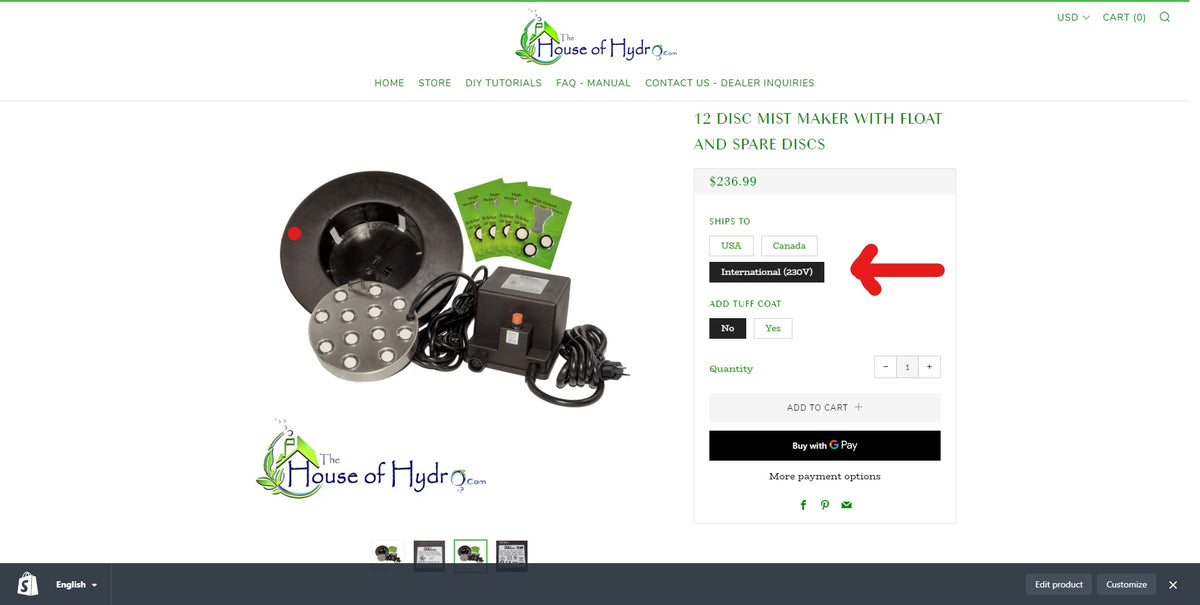
What shipping carriers and shipping speed does The House of Hydro use?
- The House of Hydro ships most orders within one business day for quick delivery.
- Small orders generally ship via the US Postal Service (USPS), which typically delivers in about 3-4 business days domestically.
- Larger orders (usually 6-disc units and above) ship via UPS Ground, which takes about 4-5 business days for delivery within the USA. Faster speeds can be chosen at checkout.
- For international orders, the customer can choose the speed at checkout. Please note: customs clearance can delay delivery.
- Tracking is provided on all shipments to keep customers informed, and quick handling ensures your mist maker arrives safely and promptly.

Do you charge sales tax?
The House of Hydro charges sales tax only if the customers delivery address is located in Florida. Florida sales tax applies to sales within the state according to Florida Department of Revenue rules, with the general state sales tax rate at 6%, plus local discretionary surtax of .5%
Warranty and Exchange
House of Hydro Mist Makers Warranty
At House of Hydro, we stand behind our mist makers with an industry-leading warranty because we believe in quality you can trust!
We work hard to keep warranty exchanges fair and fast for your humidity-critical applications. However, being fast can open the door to potential warranty fraud.
We’re a small, family-owned business run by me, John, my wife, and our two adult children. We deeply value honesty and mutual respect. Warranty fraud is theft. Please, if you wouldn’t take from someone’s wallet, please don’t take advantage of our warranty policy.
We’re here for you and your business every step of the way. Thank you for being here for ours. We truly appreciate you.
- Our mist makers come with a 1-year warranty without the Tuff Coat protective sealant and a 2-year warranty with the Tuff Coat.
- For items older than 90 days, shipping costs for warranty replacements will apply.
- Transducer warranty replacements for units over 6 months old will also require customers to cover shipping and the cost of new discs installed in the transducer.
- All other products come with a standard 1-year warranty.
Want to upgrade your unit? Customers wishing to exchange for a larger mist maker can do so within 14 days if the product is in new or near-new condition with original packaging.
Need to return? Items can be returned within 30 days if in new or nearly new condition with intact packaging. Refunds will be for the original purchase price minus any incurred shipping charges. If packaging is missing or the unit is damaged, a restocking fee of up to 20% may apply—but we’re reasonable people and won’t charge unless truly necessary.
Special note: For mist makers bought within one month of Halloween, a 20% restock fee will be applied to all returns.
Have questions? Please don’t hesitate to contact us. We’re happy to help!

